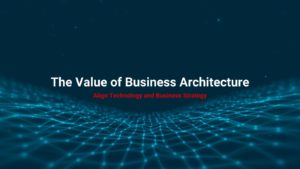As I wrote in a recent blog post, Eliminating the Blind Spot Between Business and IT Leaders, establishing a simple common language can be the key to a successful IT-enabled business transformation. In this post, I’ll be focusing on the WHEN and take a deeper dive into each phase of the journey.
Pacing and execution of the change agenda are of equal importance for real organizational change and impact, as they play a vital role in the overall journey to business transformation. As part of the WHEN journey, we describe the 5 phases that we’ve learned over the years across many transformations.
- Strategy – Future State Scenario Plan
- The Turn – Plan Detail and Repositioning the Organization
- Up & Running – Delivering the New Way
- Hitting Stride – Acceleration
- Self Sufficiency – Industrialization
Strategy – Future State Scenario Plan
No matter where we are in our journey, we must always have a Multi-Year Plan (MYP) for change.
The Strategy phase focuses on “Setting and Selling the Agenda.” The time frame is usually 3-5 years, which recognizes that a year-to-year project-based list is too short and that 5-7 years is too long to be able to project and sustain an organization’s interest and focus. The approach should be outcome-based and articulate three critical targets for Business, Architectural and Organizational Outcomes, which describe what victory would look and feel like. However, while we are imagining a Future Vision, it’s important to gather the facts about the history and the Current State in order to have a shared understanding of our starting point, as well as the decisions, patterns and dynamics that got us here.
The creative tension or distance between our Current State and unconstrained Future Vision reveals the Gap that needs to be closed and motivates business and IT leaders to engage in the conversation about the journey from here to there. The Gap Closing Plan, which begins to define the journey, work, timeframes, investments and risks, can then be developed. There are a number of different pathways to the future, some are gradual and evolutionary, while others are revolutionary. The executive team needs to judge which one best fits the strategy, goals and constraints, as well as the internal and external environment.
In almost every case, I have timeboxed this Strategy phase at 90-120 days. Any longer than about 120 days, the Strategy phase will become a “science fair” project. Any shorter than about 90 days, it won’t gain traction. This effort is mostly led by an Executive Committee/IT Leadership, with heavy engagement by the functional and business unit heads.
The Strategy gives definition, direction and pace to the transformation. By the end of the Strategy phase, we have business and IT alignment on an MYP for the journey. Once we’ve created the proper creative tension between our Current State, Future Vision and Gap Closing Plan, we are ready to begin the next phase – The Turn.
The Turn – Plan Detail and Repositioning the Organization
In this second phase, The Turn, we begin to give the Gap Closing Plan motion.
We take the MYP and drive it down into detailed sequencing and pacing of the work into an executable Plan of Record (POR) for the next 18-24 months and an Annual Operating Plan (AOP) for the next fiscal year. To do that, in a quality way, requires business and technology blueprints so that the construction process can be delivered in a series of releases that follow a clear roadmap. The first release (Beachhead) should have been selected and articulated in the Strategy. Now, in The Turn, we begin to execute and deliver the ”first of the new” business capabilities in the new way.
Full implementation of a broader set of new capabilities, such as customer experience or supply chain, can take longer and occur over a series of releases. The selection, definition and scoping of this Beachhead is critical, as it should be broad enough to create a visible success, be impactful and be small enough to be built within the first year. The Beachhead also serves to mobilize the organizational change for the WHO – Structure, Leadership, Culture, Talent and for the HOW – Planning, Governance, Investment Approach and the new common ”IT Operating Model” for quality engineering.
During The Turn phase, most of the inflight work (sometimes called the “last of the old”) will continue but not be added to. That approach will keep us stable and meeting our old commitments in Year 1, and, we should be in the process of draining “the last of the old” by finishing those inflight projects by the beginning of Year 2.
In The Turn phase, we are turning the technology, the projects and the new business capabilities, but most importantly, we’re turning people by capturing their hearts and minds with this transformation.
By the end of The Turn phase, we’ve learned the new way in a small scope (the Beachhead) and proven that the transformation is possible and valuable.
Up & Running – Delivering the New Way
We are now ready to radiate out from the Beachhead to include a wider cross-section of the MYP. We must recognize that during the Up & Running phase we may still have some remaining “last of the old” inflights to complete. However, they should be winding down in this phase and more “first of the new” from the 18 to 24-month POR should be ramping up.
This is the phase that we broaden our new MYP campaigns from just the Beachhead to the wider, Business Outcomes agenda across the business capability model. We will also be broadening our technical and data foundations. From those Architectural Outcomes, we will begin to get leverage and re-use to increase speed, quality and efficiency of new development. We should also be able to start the practice of decommissioning old/complex legacy systems as new capabilities are available to replace them.
The speed of the ramp-up and breadth of the expansion of our new way of doing things, and the focus on the new capabilities, will be paced by the economic constraints of the AOP and the organization constraints of the workforce talent. Many of our new structures, expectations and practices for our Enablement (Organization, Economic, and IT Operating) models were started in The Turn phase. Now, we need to continue to focus on fully defining, grooving and expanding our new way – so that “the new way” just becomes “THE way” going forward.
Moving beyond the “Up & Running” phase, we are ready to take our foot off the brake and accelerate the Transformation Journey.
Hitting Stride – Acceleration
The Hitting Stride phase should occur around the time we enter Year 3, although this could vary based on the size, scale and complexity of the enterprise. The hard work of the first 2 years is now paying significant dividends and delivering business value as improved speed to market, speed to merge, customer experience, etc. Moreover, we are now achieving them through a modern technical architecture, thereby reducing our technical debt and positioning the enterprise to be agile and flexible in this ever-evolving digital era. In addition to modernizing our physical IT assets, we also should be well on our way to transforming our human assets into a talented workforce capable of delivering value at speed and scale.
Each new initiative during the Hitting Stride phase should contribute to the build-out of our organization muscle, culture, operating model automation and productivity. This phase of the journey should lead us to the final phase which is Self Sufficiency, also referred to as Industrialization or sustainability. The Hitting Stride phase can take anywhere from 12-24 months before the transformation is truly secure.
Self Sufficiency – Industrialization
Since transformation will be continuous, for as long as we can see, the ability to continually transform is the end product of a successful transformation. This is actually the goal of the 3 outcomes I described in my blog post about Becoming an Agile Business – Business, Architectural and Organizational. If we deliver the 3 transformation outcomes – BUSINESS Value, Technical ARCHITECTURE and ORGANIZATIONAL Productivity (firepower) – we will truly have a sustainable transformation BECAUSE WE’LL HAVE BUSINESS AGILITY. The one thing we have continually proven is that agile organizations, the ones that can change as business models and technology changes, are the ones that will win in the 21st century and beyond.
Author: Charlie Feld, Founder, The Feld Group Institute
Connect with Charlie Feld on LinkedIn ![]()




